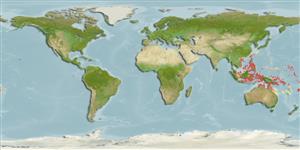>
Blenniiformes (Blennies) >
Blenniidae (Combtooth blennies) > Salariinae
Etymology: Ecsenius: Greek, exenios, -os, -on = uncontrolled, immoderate.
Environment: milieu / climate zone / depth range / distribution range
Ecología
marino asociado a arrecife; no migratorio; rango de profundidad 2 - 10 m (Ref. 90102). Tropical
Western Central Pacific: known only from the small islands in the Moluccas, New Guinea and eastward to Florida Island, Solomon Islands.
Tamaño / Peso / Age
Maturity: Lm ? range ? - ? cm
Max length : 3.0 cm TL macho / no sexado; (Ref. 48636)
Short description
Claves de identificación | Morfología | Morfometría
Distinctive species, easily identified by the thin dark lines and bright white spots. The Bali specimens are generally paler and have smaller white spots than those from Flores and Sangihe Islands but this maybe habitat related (Ref. 48636).
Adults are found solitary or in small groups perched on corals, sponges, and tunicates (Ref. 90102) in coastal reef crests (Ref. 8631, 48636). Oviparous. Eggs are demersal and adhesive (Ref. 205), and are attached to the substrate via a filamentous, adhesive pad or pedestal (Ref. 94114). Larvae are planktonic, often found in shallow, coastal waters (Ref. 94114).
Life cycle and mating behavior
Maturities | Reproducción | Spawnings | Egg(s) | Fecundities | Larva
Oviparous, distinct pairing (Ref. 205).
Springer, V.G., 1988. The Indo-Pacific blenniid fish genus Ecsenius. Smithson. Contrib. Zool. (465):134 p. (Ref. 5296)
IUCN Red List Status (Ref. 130435)
Threat to humans
Harmless
Human uses
Pesquerías: sin interés; Acuario: Comercial
Herramientas
Special reports
Download XML
Fuentes de Internet
Estimates based on models
Preferred temperature (Ref.
123201): 27.1 - 29.3, mean 28.8 °C (based on 1271 cells).
Phylogenetic diversity index (Ref.
82804): PD
50 = 0.5000 [Uniqueness, from 0.5 = low to 2.0 = high].
Bayesian length-weight: a=0.00741 (0.00335 - 0.01640), b=3.02 (2.83 - 3.21), in cm total length, based on LWR estimates for this (Sub)family-body shape (Ref.
93245).
Nivel trófico (Ref.
69278): 2.0 ±0.00 se; based on food items.
Resiliencia (Ref.
120179): Alto, población duplicada en un tiempo mínimo inferior a 15 meses (Preliminary K or Fecundity.).
Fishing Vulnerability (Ref.
59153): Low vulnerability (10 of 100).
Nutrients (Ref.
124155): Calcium = 423 [193, 1,079] mg/100g; Iron = 1.63 [0.79, 3.33] mg/100g; Protein = 17.6 [16.2, 19.0] %; Omega3 = 0.0894 [, ] g/100g; Selenium = 29.9 [9.7, 86.2] μg/100g; VitaminA = 98 [19, 511] μg/100g; Zinc = 5.25 [2.92, 8.46] mg/100g (wet weight);
